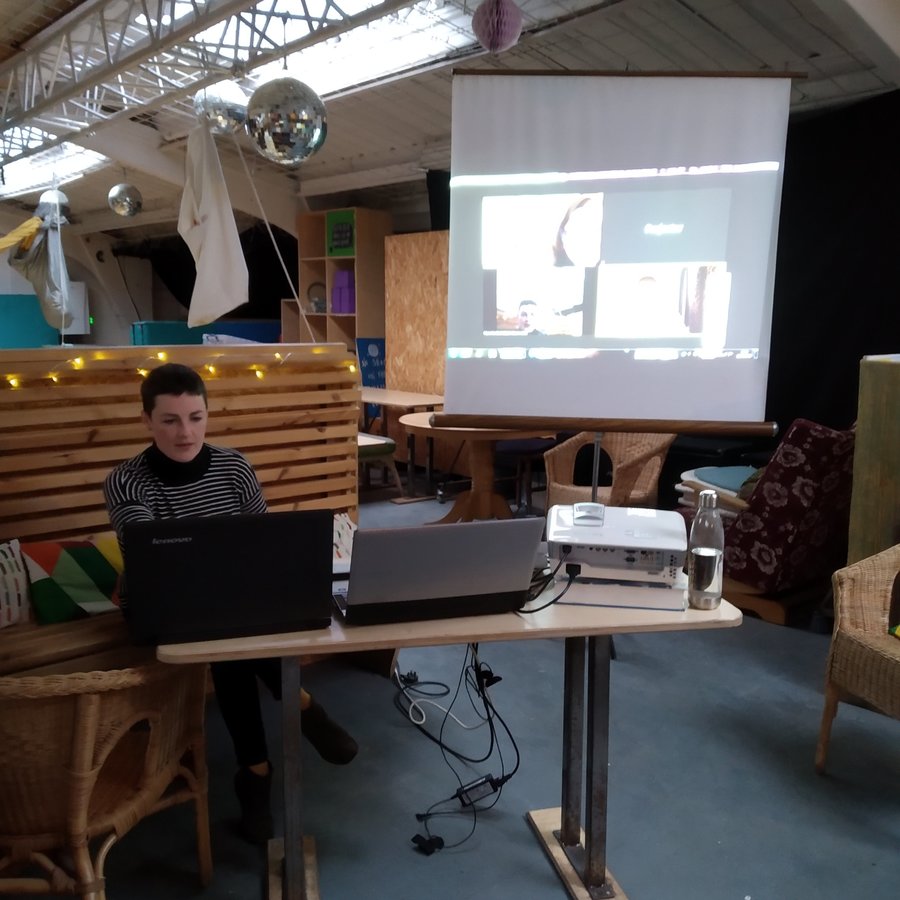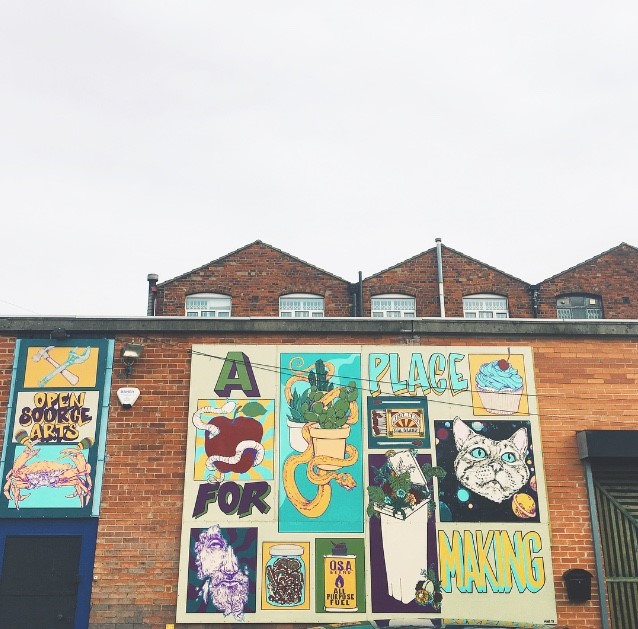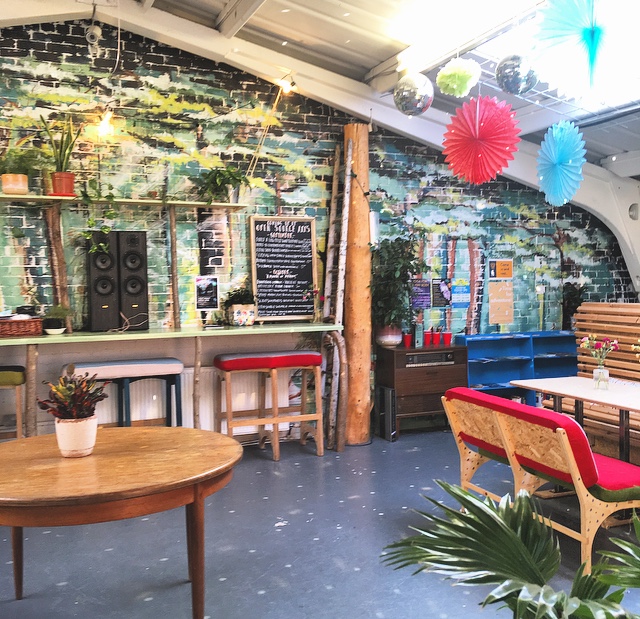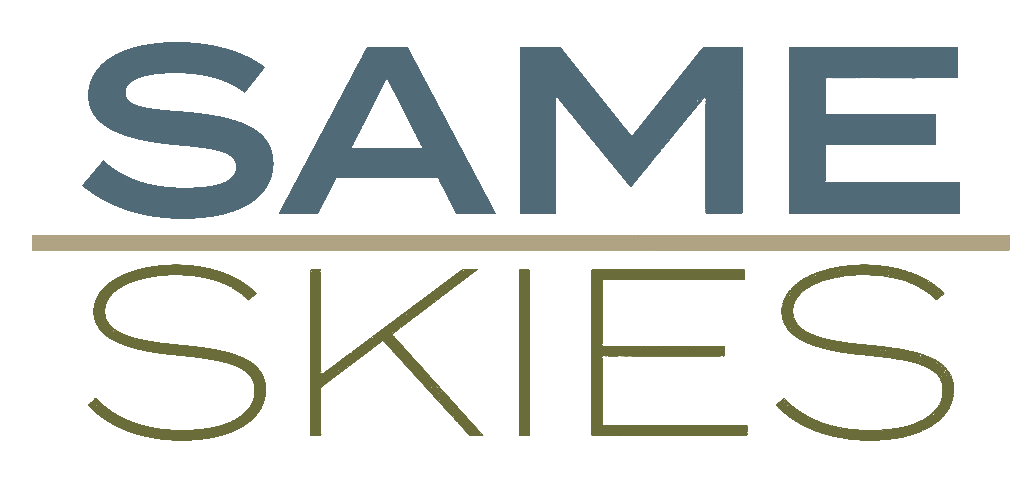Can we organise meetings that blend groups of participants on zoom and in a shared physical space?

Beginning in March 2020, the restrictions caused by the coronavirus pandemic meant that, at first hurriedly, then routinely, meetings, conferences, public lectures, launch events and the like were transferred online, usually to Zoom.
This shift has had some positive effects, most notably that people from much further afield, or pressed for time, can join live events and take part in Q&A sessions.
For some kinds of events, this can happen without changing the character of the experience. When listening to a public lecture, for example, the qualitative difference between joining on Zoom and sitting in the back of a lecture theatre is quite low, given the benefit of time saved in travelling to get there. Not much is lost in the one-way transfer of knowledge from an expert to an audience. It also allows someone with a slight interest in the topic to pop in and see if the interest grows and allows them to step out less obviously than at an in-person session. It can help those who have caring responsibilities to multi-task and still attend, or those with certain access needs or particular personalities to participate more fully. It would be a shame if these benefits fell away after the pandemic.
Where the benefit of Zoomification is less clear-cut is on the generation of new knowledge through discussions between people as peers, and on the infrastructure of physical venues for face-to-face discussions to happen.
The most obvious difference is that there is no chance to chat with people before or after the session. It is a cliche of conference attendance that the most productive discussions happen in the corridors between sessions, whether that is a catch up between people who already know each other, or new connections between people with a common interest.

The same is true of small meetings: it is difficult to use the Zoom gallery view to catch up with someone you have not seen for a while, or to have a quick word with someone afterwards. Doing either of those things now requires a pretext to set up a more formal meeting, so the casual exchange of knowledge is lost. Even more importantly, there is less opportunity for the conversations that serve to maintain ongoing trust, which allows working relationships to be picked up again quickly when the need arises. This seems inconsequential but is far from it. Maintaining trust by doing talking, rather than having important information to exchange, is anthropologist Robin Dunbar's explanation for why humans evolved language in the first place. At the moment there seems no way to directly replicate this for online meetings.
In the last eight months we have all become sophisticated enough Zoom users to set up break out rooms, but it is not yet clear whether this matches the richness of interactions in small face-to-face groups, especially if the group need to reach a conclusion together. The less fluid turn-taking that Zoom enforces might have an effect on who speaks, how often and when. In face-to-face meetings women speak fewer times than men unless they outnumber men in the group by at least 4-to-1 or the meeting has to reach a consensus. Is this imbalance replicated in Zoom meetings? Does Zoom flatten non-verbal signals that convey not only wanting to speak, but enthusiasm, disagreement, anger, disengagement, uncertainty? Does that flattening have an effect on the quality of the conclusions reached?

Video conferencing has been around for decades, so there will already be lots of computer science research on the subject, but unless it is overwhelmingly conclusive, it seems best to guard against a consequence of the pandemic that is "Let's do everything online". Especially if what that really means is funding bodies saying: "You have to do it online because it's cheaper so you'll need less funding." There is a danger that the long-term effect of coronavirus may be the opposite of the short term - that digitised events are for the poor, and physical events are reserved for the rich. Digital poverty means that online events can be less accessible to people rather than easier to attend. We wonder if offering the blending of online and the physical world can make meetings more accessible and easier for people to participate, giving them a choice for which suits them best.
Anyone who has ever started any sort of grass roots collective activity knows how invaluable easy-to-access and flexible meeting and multi-use event spaces are, especially if they can be had for free or at low cost. These spaces are often independently-run community centres and arts spaces, and they are scarce at the best of times. But because they are multi-use, this makes them much more difficult to categorise for institutional support, especially in the arts. A theatre that puts on plays is an easy tick for arts funding, but space for people to organise what they want to organise is the sort of thing that it is easy to undervalue. If we are going to "build back better", a slogan that already risks seeming naive in its optimism, we are going to need more of these spaces where unpredictable things can happen, not less.
With all these considerations in mind, Open Source Arts and Same Skies used the window after the first lockdown and before the rolling "tier 3" restrictions were imposed on West Yorkshire to organise an experiment with a blended event combining participants in the same physical space with those online.
The event had both the speaker-to-audience presentation element, and person-to-person discussions in break out rooms, in which the groups contained a combination of people together in the physical space and online. We deliberately didn't split into all-online and all-physically-present groups.
Our aim was to test what happened if we tried to combine the benefits of online and physical world events, and to do so with only the resources available to small, independent groups and organisations: laptops, Zoom, wifi and the Open Source Arts physical space. That means our experiment is open to any small organisation that wants to try it.
The experiment was about looking forward, beyond where we are now, rather than just responding to the constraints of the moment. What can we take that’s positive, and what can we make that’s new?
Below we outline what we did, and what we learned. We would be very interested to hear from other small groups who have tried anything similar.
EVENT STRUCTURE
The session was themed around a question, "Can We Have a Circular Digital Economy in West Yorkshire?" and aimed to generate new ideas through expert knowledge and discussions between peers.
Section 1, Speaker Presentations
3 speakers, all online and in different places.
The zoom session was projected onto a screen in the physical space.
Our speakers were:
Dr Anne Velenturf, Research Impact Fellow in Circular Economy & Sustainable Offshore Wind Development at Leeds University.
Ben McKenna, founder of Solidaritech, a non-profit that helps Refugees and Asylum Seekers get access to technology, and a co-founder of Digital Access West Yorkshire.
Amani Talheth-Fell, founder of Community Action on Waste, a community co-operative group trying to end the problem of student waste.
They brought specialist knowledge, inspiration and practical examples to get us thinking.
Section 2, Small Group Working
Splitting into smaller groups of around 5 people.
Each group mixing some of the people in the physical space with some in the online space.
The aim of the smaller groups was firstly to make more connections, and gather some collective knowledge about what was already happening in West Yorkshire. Secondly to try to come up with some new ideas to explore further, and perhaps collaborate.
Section 3, Coming Back Together
Coming back together to share discussions, socially distanced in the physical space and back to one group in the shared zoom session.
SETTING UP THE EVENT
Registration
Two different eventbrite pages, with people asked to register for either the physical event or the online one but not both.
Equipment
laptops - 1 for Zoom host, 1 for projector
physical space hosts with laptops
projector
audio
People
enough facilitators with laptops for the number of physical space groups
Physical breakout spaces
- out of earshot of each other so not distracting, and audio not feeding back over zoom.
- power for facilitators' laptops
- table and circle of chairs for physical participants
- table to place facilitators laptop on
- speakers for facilitator's laptop
RUNNING THE EVENT
Section 1, Speaker Presentations
Presentations in the same way as a regular Zoom presentations session online, and projected in the physical space.
Section 2, Small Group Working
In the physical space split into groups, separate people who have come together.
Online people were put into breakout rooms, and a group facilitator in the physical space had the breakout room on their laptop, which they positioned at one end of a table with physical space people sitting round it.
Physical groups need to move from the main presentation area to different parts of the space to become a group.
Online assign to Zoom breakout rooms – much quicker than the movement of people around the physical space .
Section 3, Coming Back Together
Couldn't do this because time overrun, and because we had only one Zoom host who was involved in one of the conversations, so no one could close the breakout groups and get everyone back together easily.
OUTCOME
Can We Organise Meetings That Blend Both Zoom and Physical World Participants?
This meeting, blending both zoom and physical world participants, worked well, with discussions flowing between both those online and in the space. The zoom chat was used minimally throughout this meeting, with people verbally contributing.
Feedback from someone attending online:
"It made me reset some thinking towards a focus on collaboration after chatting with some of the others at the meeting"
The presentations delivered by those on zoom were well received by both the physical world and zoom world participants, with respectable visuals and audio in both settings. Some of the transitions could have been smoother with another facilitator involved, or without covid requiring a 1m+ physical distance between the two facilitators.
Keeping covid secure at 1m+ distance from other people reduced the number of people who could safely sit around one laptop and still see and hear clearly. However, we found that 3 people could comfortably do so.
One of the presenters mentioned that they lived a fair distance away from the physical venue, and they really appreciated the option to attend online for reduced travel time as well as to reduce covid transmission. Another participant talked about how much they valued and preferred the option to attend in person.
Feedback from someone attending the physical space:
"Great to have the option to be here – I really enjoyed the human in-person element of the event. It was great to have the opportunity to talk (across platforms) about the schemes after the presentations. 5 people – in-person and on zoom – was a good amount."
Open Source Arts intends to continue and increase their experience and offering of blended events, with the aim that this can improve accessibility for a wider variety of people in different circumstances to participate. Following this event, they started to host blended performance events which are live streamed along with a small audience in the physical space.
WHAT WE WOULD DO DIFFERENTLY
Registration
Did people accidentally book for the physical space who thought it was an online only event?
Need much better idea of how many people are attending, in order to be able to balance mixed online and physical world groups. Might have to charge for tickets to reduce the dropout rate?
Timekeeping
For presenters on Zoom and Zoom timer on the breakout groups.
Don't try and fit too much in
Record the discussions in a way which enabled the online and physical participants to see and hear it and feedback together.
People
Have another facilitator to organise the logistics, or a second person on laptop?
About Open Source Arts
Open Source Arts works on the boundary of the arts, community, and civic society. Offering space and tools for making, practicing, and doing, across sectors, backgrounds, and skill levels. Inviting creative, participatory solutions and ideas to the challenges which unite us, and to move us towards the sustainable futures we all want to create.
Housing and planning powers in the West Yorkshire Devolution Deal 2020
How can we link ideas for positive change in the region to formal structures, processes and policies in order to influence what actually gets done …
Understanding The Challenges: South Asian Muslim Mental Health in West Yorkshire
The early teachings of Prophet Muhammad (peace and blessings be upon him) highlight the basic equality of all human beings, laying the groundwork for an …
Sharing Umbrellas Part 2: An Interview with Landscape Architect Bridget E. Snaith
In the second part of Sharing Umbrellas, her report on our West Yorkshire Walks in Harehills, Leeds, in July 2023, Vivien De Brito interviews landscape …
